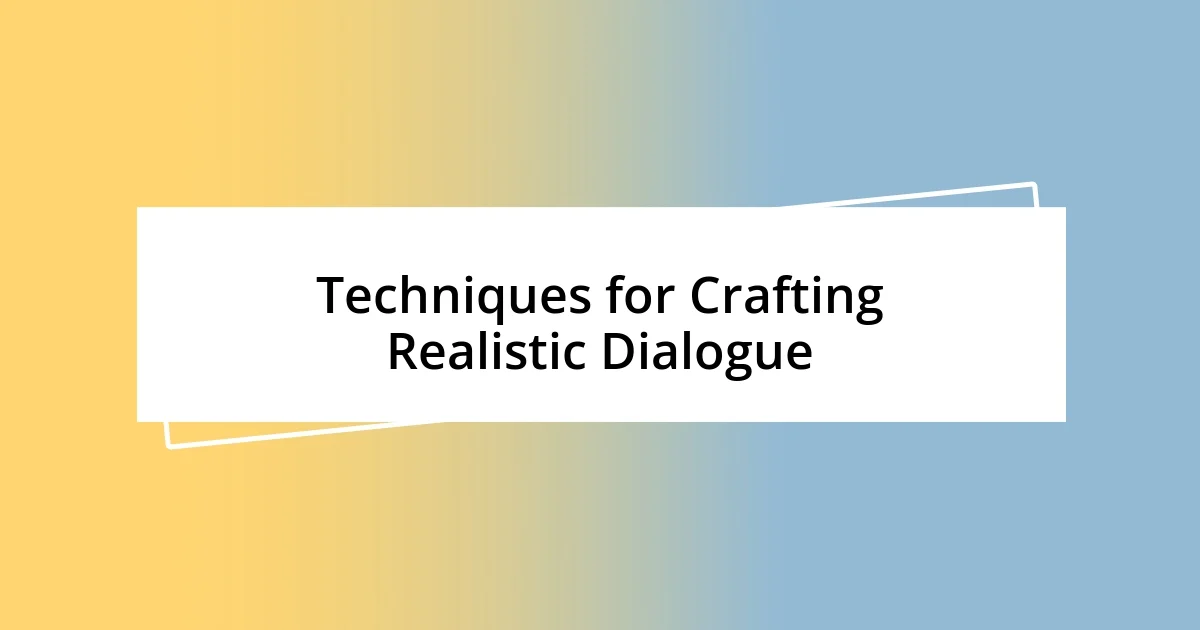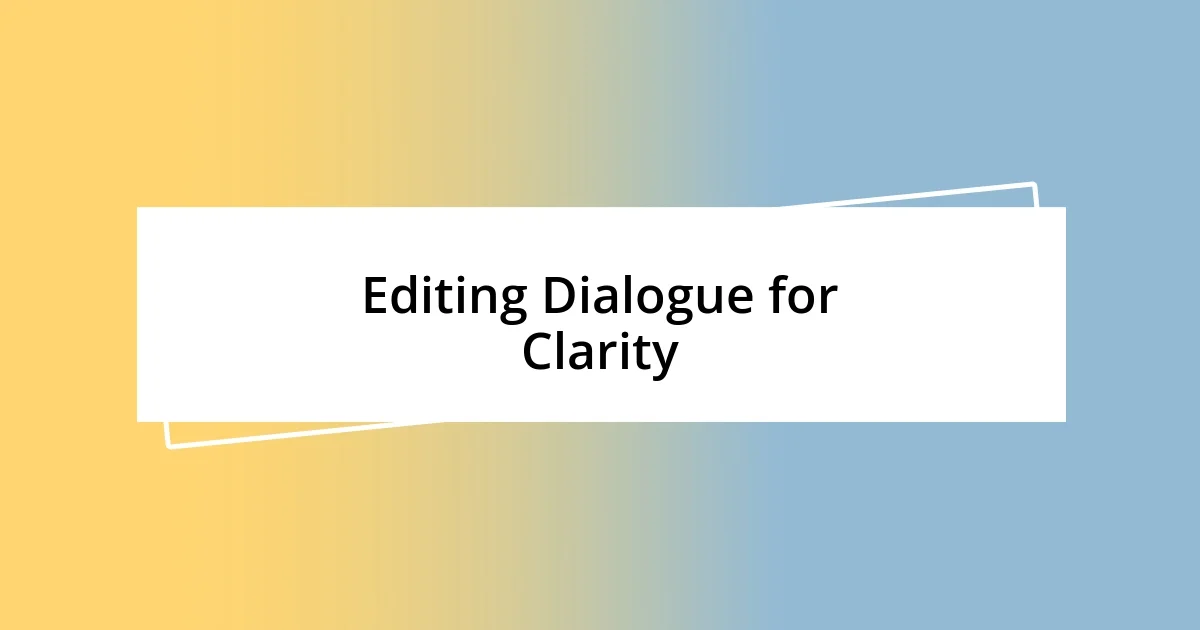Key takeaways:
- Effective dialogue reveals character traits and drives the plot, mirroring real-life conversations with authenticity and emotional depth.
- Common mistakes in dialogue writing include overly formal language, lack of distinctive voices, and neglecting to show emotions; clarity and natural flow are essential.
- Practicing dialogue exercises, such as rewriting existing scenes and role-playing, helps develop authentic voices and showcases the importance of subtext and context in character interactions.

Understanding the Importance of Dialogue
Dialogue is a powerful tool that breathes life into characters and drives the narrative forward. I remember the first time I realized this while reading a novel. A simple exchange between two characters made me feel their tension and excitement more than any description could—it was like peeking into their hearts. How often do we empathize with a character based on what they say rather than what they look like?
When crafted well, dialogue not only reveals character traits but also serves as a vehicle for the plot. Take, for instance, a conversation that unveils a character’s backstory; it can transform a flat character into someone the readers can connect with. I know it can be challenging to strike this balance, but when I finally worked on making dialogues more natural and relatable, my characters felt more authentic and engaging.
What’s fascinating is how dialogue can mirror real life, filled with pauses, interruptions, and unfinished thoughts. I once found it challenging to replicate this authenticity on the page. However, after paying closer attention to my own conversations, I realized that our words often dance around unexpressed feelings, and capturing that in dialogue can create deeper emotional resonance for the reader. Have you ever noticed how a single line can change the entire tone of a conversation? That’s the magic of dialogue!

Common Mistakes in Writing Dialogue
One of the most common mistakes I encounter in writing dialogue is making it too expository. I remember a time when I had characters recapping events instead of letting their conversation flow naturally. It felt forced and stilted, pulling readers out of the story. Dialogue should reveal, not summarize; it needs to sound like a real conversation.
Here are some errors to watch out for:
– Overly Formal Language: Characters often sound more like robots than real people.
– Lack of Distinctive Voices: Every character should have a unique way of speaking.
– Using Dialogue Tags Excessively: Relying too much on “he said” or “she exclaimed” can distract from the conversation.
– Forgetting to Show Emotion: Dialogue should convey feelings, not just words; body language matters.
– Feeling the Need to Explain Everything: Sometimes, less is more; leave space for readers to infer.

Techniques for Crafting Realistic Dialogue
One effective technique I’ve found for crafting realistic dialogue is to listen and observe the way people converse in real life. I remember sitting in a café, absorbing snippets of conversations around me—the overlapping chatter, the laughter, the pauses. These elements create a vibrant tapestry of human interaction that I strive to emulate in my writing. By incorporating similar dynamics into my dialogue, I can create scenes that feel more alive and relatable.
Another approach is to focus on subtext, which is the underlying message or emotion conveyed in a conversation. I once wrote a scene where two characters appeared calm, but their words were laced with tension. This nuance not only added depth to their interaction but also engaged readers, inviting them to read between the lines. Remember, what isn’t said often speaks louder than what is.
Finally, varying the rhythm and pace of dialogue can significantly enhance realism. Think about how a conversation can go from slow and thoughtful to fast and chaotic in mere moments. I often experiment with sentence lengths and punctuation to mirror the ebb and flow of actual speech. It’s fascinating how temporary changes in pacing can heighten the tension or excitement within a scene.
| Technique | Description |
|---|---|
| Observation | Listen to real conversations to capture natural speech patterns. |
| Subtext | Convey deeper meaning through implied emotions and unsaid thoughts. |
| Varying Rhythm | Adjust sentence length and pace to reflect realistic conversational flow. |

Balancing Dialogue and Narrative
Finding the right balance between dialogue and narrative has been one of my ongoing challenges. I recall a moment when I poured my heart into writing a dialogue-heavy scene, only to realize that the surrounding narrative was too sparse. It felt as if I had constructed a beautiful painting but forgot to frame it. A well-rounded scene needs both elements to shine—you want your characters’ words to breathe life into the story, but they also need the narrative to anchor them in a vivid setting.
When I think about this balance, I often remind myself of the importance of context. In one of my stories, I wrote a heated argument between two friends, but without any narrative description, the intensity was hard to appreciate. Adding layers of detail—like a storm brewing outside or the smell of burnt popcorn—enhanced the dialogue, creating a more immersive experience for the reader. It’s fascinating how a few carefully chosen words of description can transform a good scene into a gripping one.
Here’s a question I often ponder: How do we keep readers engaged without overwhelming them with information? Personally, I’ve found that sprinkling bits of exposition within the dialogue tends to work well. I once had a character refer to a shared memory during a conversation, seamlessly revealing essential backstory without overshadowing their current exchange. That delicate weaving of narrative and dialogue can create a rhythm that keeps readers thoroughly entertained, urging them to turn the page for more.

Using Subtext to Enhance Dialogue
Subtext is like the heartbeat of dialogue; it gives depth to what characters say (or don’t say). I remember writing a scene between a mother and daughter where they appeared to discuss an upcoming family dinner. On the surface, everything seemed fine, but underlying tensions stirred. The daughter’s seemingly casual comment about the guest list hinted at unresolved conflicts. This subtlety hooked readers, encouraging them to ponder the unspoken nuances of their relationship.
One of the most intriguing aspects of subtext is that it often elicits stronger emotional reactions than straightforward statements. In another story, I crafted a conversation between two colleagues who congratulated each other on a recent promotion. While their words were congratulatory, their body language—the lingering glances and forced smiles—conveyed jealousy instead. This discrepancy between what was said and what was felt allowed readers to connect with the characters on a deeper level, creating an engaging tension that lingered long after the dialogue ended.
When we consider crafting dialogues, I find myself asking, “What’s left unsaid?” This question has shaped my approach significantly. By focusing on the spaces between words, I’ve discovered that characters often reveal their true selves through hesitation and omission. In a personal piece, I had a character avoid discussing a touchy subject with a friend. The resulting silence emphasized their emotional struggle, drawing readers into the internal conflict. Exploring subtext opens up a world of complexity that enriches both the characters and the narrative, making every conversation a nuanced dance of meaning.

Editing Dialogue for Clarity
Editing dialogue for clarity is a crucial step that I often find myself tackling after the first draft. I recall a time when I meticulously crafted a conversation between two characters, only to realize later that their banter was rife with confusing references and obscure language. Readers might have simply glanced over my carefully written words instead of digesting them. This experience taught me that clarity doesn’t mean stripping away personality; it means ensuring that each line is comprehensible and impactful.
Sometimes, it’s as simple as reading the dialogue aloud. I remember doing this after finishing a particularly intricate scene where the characters discussed their dreams. Listening to the dialogue helped me identify phrases that sounded awkward or overly convoluted. As I spoke the words, I realized some lines needed streamlining. It’s amazing how hearing the dialogue can illuminate its flow, revealing areas where clarity needs to shine through.
I often ask myself, “Are my characters truly communicating, or are they just talking?” The difference is subtle yet profound. I once edited a poignant conversation between a grandfather and his granddaughter. Initially, they both spoke in riddles, which was poetic but ultimately unclear. After diving into my editing process, I shifted their dialogue to be more straightforward, allowing their emotions to resonate more deeply. This change transformed a puzzling exchange into a memorable moment that readers could deeply connect with. Clarity in dialogue doesn’t just enhance understanding; it fosters genuine emotional connections.

Practicing Dialogue Writing Exercises
Practicing dialogue writing exercises can be a game-changer for developing authentic character voices. I think back to a time when I dedicated a day solely to writing snippets of dialogue without overthinking it. This exercise pushed me to not just focus on what was being said but how it was being expressed. I found that the more I allowed my characters to speak freely, the more their distinct personalities emerged.
One exercise I particularly enjoy involves taking a scene from a book or movie and rewriting the dialogue from scratch. It’s like a mini-challenge that forces me to consider different emotional angles and intentions behind the words. In doing this, I once transformed a simple coffee shop interaction into a heated debate about trust. By experimenting with various tones, I discovered how dialogue can shift the dynamics of a scene in surprising ways.
Another useful exercise involves role-playing different characters in a scenario. I remember setting up a fictional argument between two friends, each with opposing views. As I slipped into their roles, I realized how their backgrounds influenced their speech patterns and reactions. This exercise was illuminating; it reinforced how much the context and history shape language and can lead to compelling conflicts. Have you tried this? It’s incredibly insightful to see how something as simple as a disagreement can unveil depth in character development.














